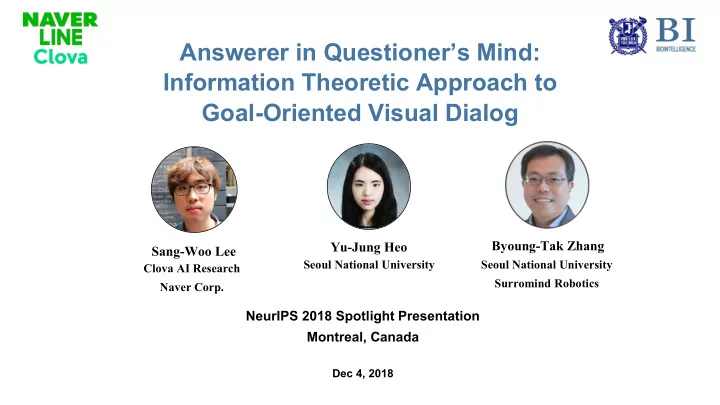

Answerer in Questioner’s Mind: Information Theoretic Approach to Goal-Oriented Visual Dialog Byoung-Tak Zhang Yu-Jung Heo Sang-Woo Lee Seoul National University Seoul National University Clova AI Research Surromind Robotics Naver Corp. NeurIPS 2018 Spotlight Presentation Montreal, Canada Dec 4, 2018
Problem Definition – GuessWhat?! H. de Vries, F. Strub, S. Chandar, O. Pietquin, H. Larochelle, and A. Courville. Guesswhat?! visual object discovery through multi-modal dialogue, CVPR, 2017. Yes / no Questioner Answerer Q 2
Previous Architectures F. Strub, H. de Vries, J. Mary, B. Piot, A. Courville, and O. Pietquin. End-to-end optimization of goal-driven and visually grounded dialogue systems, IJCAI, 2017. The goal of study is to increase the performance of machine-machine game and make emerged dialog from two machines. SL and RL are used to train question-generator and guesser. Supervised learning: The questioner and the answerer trains from the training data. Reinforcement learning: The questioner and the answers play a game, and use the dialog log for the training data. Question-generator Answer-generator Guesser 3
Our Method - AQM (Answerer in Questioner’s Mind) Our Goal: Making a good questioner. Not an answerer (VQA model). Our model asks question as solving 20 questions game. I C A q a [ , ; , , q ] − − t t 1: t 1 1: t 1 p a ( | , c q a , , q ) = ∑∑ − − p c a ( | , q ) ( p a | , c q a , , q )ln t t 1: t 1 1: t 1 − − − − 1: t 1 1: t 1 t t 1: t 1 1: t 1 p a ( | q a , , q ) a c − − t t 1: t 1 1: t 1 t t ∏ ∝ p c a ( | , q ) p c ( ) p a ( | , c q a , , q ) − − 1: t 1: t j j 1: j 1 1: j 1 j 4
Experimental Result 5
Experimental Result Retrieve from training data or Generate from SL model Sample candidate questions from training dataset or from SL neural model 6
Conclusion & Argument Conclusion We propose a practical goal-oriented dialog system motivated by theory of mind. We test our AQM on two goal-oriented visual dialog tasks, showing that our method outperforms comparative methods. We use AQM as a tool to understand existing deep learning methods in goal-oriented dialog studies. We extend AQM to generate questions, in which case AQM can be understood as a way to boost the existing deep learning method. Argument The objective function of AQM is indeed similar to RL in our task. Learning both agents with RL in self-play in our task basically means that training the agent to fit the distribution of the other agent, making their distribution for from human’s distribution. See you at Poster session Tue Afternoon 95 & ViGIL workshop Fri for a future work of AQM! 7
Recommend
More recommend